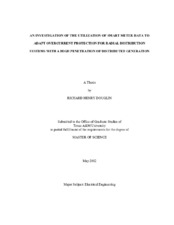| dc.description.abstract | The future of electric power distribution systems (DSs) is one that incorporates extensive amounts of advanced metering, distribution automation, and distributed generation technologies. Most DSs were designed to be radial systems and the major philosophies of their protection, namely, selectivity and sensitivity, were easily achieved. Settings for overcurrent protective devices (OCPDs) were static and based on the maximum load downstream of its location, with little concern of major configuration changes. However, the integration of distribution generators (DGs) in radial distributions systems (RDSs) causes bidirectional power flows and varying short circuit currents to be sensed by protective devices, thereby affecting these established protection principles.
Several researchers have investigated methods to preserve the selectivity of overcurrent protection coordination in RDSs with DGs, but at the expense of protective device sensitivity due to an inherent change in system configuration. This thesis presents an investigation to adapt the pickup settings of the substation relay, based on configuration changes in a DS with DGs, using smart meter data from the prior year. An existing protection scheme causes the faulted areas of DSs with DGs to revert to a radial configuration, thereby allowing conventional OCPDs to isolate faults. Based on the location of the fault, the created radial segments are known and vary in length. The proposed methodology involves using demand information available via smart metering, to determine the seasonal maximum diversified demands in each of the radial segments that are formed. These seasonal maximum diversified demands are used to yield several pickup settings for the substation overcurrent relay of the DS.
The existing protection approach enables the selectivity of radial overcurrent protection coordination to be maintained; the sensitivity of the substation relay is improved by adapting its pickup settings based on seasonal demand and system configuration changes. The results of the studies are reported through simulation in EMTP™ /PSCAD® using a multi-feeder test system that includes DGs and smart meters located at the secondary distribution load level. The results show that using seasonal settings for the substation relay based on configuration changes in a DS with DGs can improve the sensitivity of the substation relay. | en |


